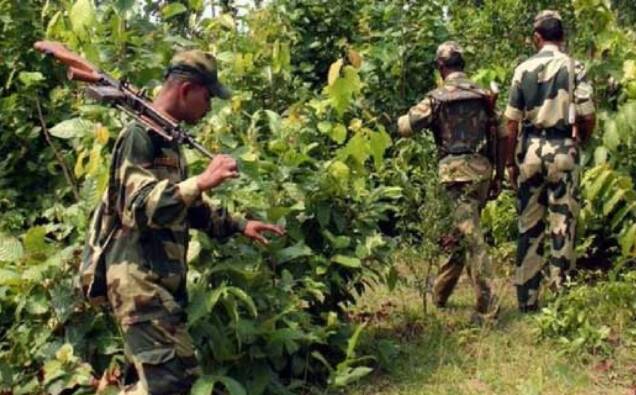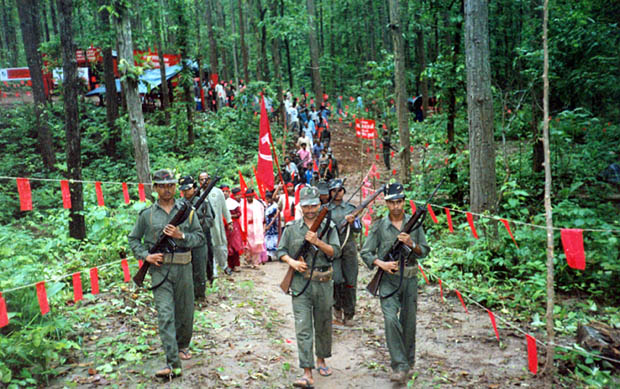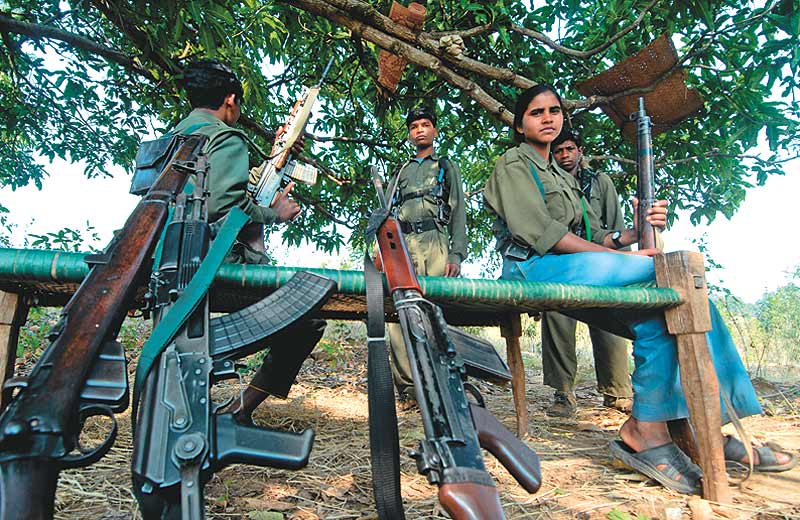
The first part of this article analysed author Uddipan Mukherjee’s seminal work on “Intellectuals And The Maoists”, describing the early concepts “ideology”, “intellectual” and “revolution” by citing examples and writings of western Marxists, philosophers, and intellectuals; as also their lasting and continuing influence on their Indian counterparts.
The second part of the article deals with the events after the early Naxal movement fizzled out in a storm of wanton violence; and how the splits and mergers in its wake gave rise to a broad and dangerous network of rural Maoists and urban Naxals hell bent on defying the writ of the Indian State and its Constitution.
Mukherjee tracks the splits, mergers and re-emergence of the Maoists in different avatars across India’s red corridor through the observations of journalist, author and activist Sumanta Banerjee:
“As Sumanta Banerjee observed, the movement fizzled out with a “farrago of factions” and gradually the scene as well as the leadership rotated outwards from West Bengal to Bihar and Andhra Pradesh. The baton of the race, which was left unattended, was picked up by two disconnected groups – the Kanhai Chatterjee-Amulya Sen faction giving rise to the Maoist Communist Centre [MCC] in Bihar; whereas three groups emerged in Andhra Pradesh – led by Nagi Reddy, Chandra Pulla Reddy and Kondapalli Seetharamayyiah. Eventually, in the 1980s, the Kondapalli Seetharamayyiah-bred People’s War [CPI (M-L) (PW)] emerged as the major faction.”
Mukherjee says he interviewed ex-Naxals of the late 1960s, belonging to both their ideological realm as well as squad action teams, who are now leading cosy lives in Kolkata either as government officials or entrepreneurs. “A more or less unanimous verdict oozed out.”
“We committed errors. We should have taken the masses into confidence. Alienating them was a grave mistake.
“Furthermore, interviews with people affected by the Naxal violence of the early 1970s in then North Calcutta brought out stories that indicate ruthlessness and immaturity on the part of the erstwhile and so-called revolutionaries.
“Accepting the wrong tactics and to some extent the philosophy are the causes of failure that were identified by other ex-Naxal leaders like Kanu Sanyal (who reportedly committed suicide in 2010). Charu Mazumdar’s annihilation line led them nowhere.
“The failure of the first avatar of the movement probably provided the Maoists the lessons to couple Guevara’s foco theory with Mao’s protracted people’s war as a model, more or less successfully applied in the Bastar-Abujhmaad region, in the post-Charu period.
Modern-Day Cheerleaders
Mukherjee says opinions of contemporary scholars and writers have varied regarding the ongoing ‘conflict’ in the wide strip of land stretching from the Indo-Nepal border in the north to the Nallamala jungles in the south.
“Aruna Roy, Mahasweta Devi et al., firmly believe that the adivasis may genuinely ‘protest’ against maladministration. However, they have overtly not adhered to the view that the ‘Maoist-type of insurgency’ is the acceptable format of protest. They basically stress on ‘separating’ the tribal-adivasi from the Maoist insurgent.
“On the other hand, Arundhati Roy opines that the Maoists have in essence granted the tribal-adivasis a semblance of dignity. At least, the importation of the gun, according to Roy, if not the ideology, has given the poverty-stricken adivasi a weapon to engineer ‘survival’; if not emancipation.
“Bela Bhatia too, while analysing the Naxalite movement in Central Bihar, agrees that the Naxalites (pre-2004 era) empowered the labouring and oppressed classes of the region. Nonetheless, she feels that the Naxalite leaders are not interested (emphasis added) in ‘development’ and hence the quality of life in the villages has not improved.
“Gautam Navlakha even goes to the extent of conflating the tribal with the armed Maoist.
Mukherjee then proceeds to do a detailed autopsy of writer-activist Arundhati Roy’s lengthy essay: “Mr Chidambaram’s War – India’s War on its Indigenous Peoples” (Outlook magazine, October 2009). Here, he gives a point-by-point rebuttal of Roy’s various assertions; acknowledging valid points and demolishing what he asserts are rather exaggerated, even invented data and facts!
Below are some of Mukherjee’s observations on Roy’s famous essay on the armed struggle by Maoists to bring justice to the plight of India’s tribal-adivasis. The assertions made by Roy should give a sense of how the LWE narrative has shaped in the past few decades in this country.
To quote her: “They’re pitted against a juggernaut of injustices, including policies that allow a wholesale corporate takeover of people’s land and resources…
“This is sheer hyperbole… Statements like “wholesale corporate takeover of people’s land and resources” and “the women raped as a matter of right by police and forest department personnel” are horrendous and mirror a Bollywood movie script rather than any description of fact.
Further, Roy laments: “Right now in central India, the Maoists’ guerrilla army is made up almost entirely of desperately poor tribal people living in conditions of such chronic hunger that it verges on famine of the kind we only associate with sub-Saharan Africa.”
“This is another extreme exaggeration. Roy should present proper data in order to corroborate her assertions. True, there is poverty, hunger and malnutrition in India, even after seven decades of independence. But that does not necessarily make India comparable to sub-Saharan Africa!
“One fails to gauge why Roy doesn’t join the ranks of the Maoists, when we come across the line, “Their journey back to a semblance of dignity is due in large part to the Maoist cadre who have lived and worked and fought by their side for decades…
“Arundhati Roy fails to mention, inter alia, about the Right to Information Act (2005) or the National Rural Employment Guarantee Act (NREGA), which have made independent India proud and have provided benefits to millions of the poor. On most occasions, she looks at just one side of the coin.
“The fact of the matter is that a Mumbai-born Kobad Ghandy or a Ganapathy have simply displaced a modern-day Birsa Munda or a Sido. Instead of being the torch-bearers for the ‘subaltern adivasi’, the Maoist leadership has undertaken a ‘struggle for power’, enmeshed in their own intellectual abstractions of dismantling the purportedly comprador bourgeoisie Indian democracy.
“To a large extent, this idea seems to be echoed by past Naxalite leaders like Kanu Sanyal and Azizul Haq. Amusingly, they hold the opinion that the present Maoist struggle is nothing but a ‘power struggle’ and is using the tribal peoples as pawns.
Mukherjee talks about his conversation with Abhijit Mazumdar, Secretary, Darjeeling District Committee, CPI (Marxist-Leninist) Liberation, and the son of Charu Mazumdar. “An intellectual by his own right, Abhijit Mazumdar argues that the role of avant garde intellectuals globally is hailed in Marxist history…

“In an inner-party note, Charu babu had asserted that in reality the true Indian culture is a product of cultivators (agriculture > culture) and the artisans; it further hinges on the mode of production and the relations of production. His son Abhijit babu lauds public intellectuals like Amartya Sen, Irfan Habib, Romila Thapar, Arundhati Roy and Ramchandra Guha, for carrying on with “this essential dialectical take” of Charu Majumdar.
Who Is An Urban Naxal?
Mukherjee then moves on to the topic of the ‘Urban Naxal’.
“In August 2018, activists Sudha Bharadwaj, Gautam Navlakha, Varavara Rao, Vernon Gonsalves and Arun Ferreira were arrested by the Police in simultaneous country-wide operations. The houses of few other activists and lawyers were also searched. They were accused of involvement in the
Bhima Koregaon violence and of having ties with the Maoists.
“Marxist historian Romila Thapar petitioned in the Supreme Court against the house arrest of five activists arguing: “We were all born Indians, lived as Indians all our lives. These activists are fighting for good causes and terming them Urban Naxal is a political move.”
“Erstwhile researcher of the Manohar Parrikar Institute for Defence Studies and Analyses, P.V. Ramana, explains the term ‘Urban Naxalism’:
“The presence of, and activities carried out by, Naxalites, or the CPI (Maoist), in urban areas –– towns and cities –– are together termed as Urban Naxalism. The activities of the Maoists in urban areas include maintaining safe houses for leaders and cadres while in transit, place for recuperation and for holding meetings; providing logistics support to under-ground squads; mobilising and recruiting youth, students, academics and workers from industry and other organisations.
“In this regard, advocate Vrinda Grover’s caustic remark is significant as she asserts that the term ‘Urban Naxals’ has been coined and deliberately placed in the public discourse to demonise dissent. While at the other end, Union Home
Minister Amit Shah visited the Central Reserve Police Force (CRPF) headquarters and made clear his no-nonsense approach against Urban Naxals and their facilitators.
Maoists’ Urban Perspective
In the final segments of his article, Mukherjee focuses on the Indian Maoists’ Urban Perspective.
“…After the grand merger of the two major Naxal splinter groups in 2004, a series of bulky documents from the side of the Maoists have made their way into the public domain, which speaks volumes of their refined doctrinal position vis-à-vis strategy and tactics, especially for urban areas.
“Out of those documents, two merit serious attention and analyses. The first is the “Strategy and Tactics of Indian Revolution” prepared in September 2004 (henceforth STIR). The other one came out three years later; termed the “Urban Perspective: Our Work in Urban Areas” (henceforth UPUA). In the backdrop of the recent spate of arrests of ‘Maoist activists’ from urban areas and cities, it appears that a re-reading of the two documents to decipher the long-term strategy of the Indian Maoists has become a necessity.
“In STIR, the Maoists stress on the large concentration of the petite bourgeoisie in urban areas of India. It is no wonder that the rebels are still basing their revolutionary tactics on the lower middle class of Indian society.
Further, the UPUA of 2007 states: “Working class leadership is the indispensable condition for the new Democratic Revolution (NDR) in India. Working class has to send its advanced detachments to rural areas.”
Mukherjee says, according to the Indian Maoists: “… the specific characteristics of revolutionary war in India is to determine the military strategy as that of protracted people’s war – of first establishing revolutionary base areas in the countryside where the enemy (read the government) is militarily weak and then to gradually surround and capture the cities which are bastions of the enemy forces.
“Mao Tse-tung had, in fact, stated: “… the final objective of the revolution is the capture of the cities, the enemy’s main bases, and this objective cannot be achieved without adequate work in the cities.
“Che Guevara also opines: “The importance of the urban struggle is extraordinary.”

“The Maoists assess that presently, India has a larger proportion of the population in urban areas and a much larger working class than at the time of the Chinese revolution. This increases the relative importance of urban work in the particular conditions of the Indian revolution.”
Guerrillas in Urban Spaces
According to Mukherjee, the main challenges that the Maoists face in the urban areas are:
- Democratic party-system is well entrenched in the cities and urban areas. So, it is extremely tedious to dent the political ethos in cities and towns.
- Extremely strong administrative machinery exists in these regions and thus counterinsurgency will be effective.
- The trade unions, which are a potentially fertile ground for fomenting dissatisfaction amongst the urban proletariat, already have established ties to mainstream political parties.
- The presence of the Maoists in key industries like defence production, telecom and the like are poor.
“Undoubtedly, an urban base can provide logistical support to the armed struggle, i.e. technical and medical help. It further helps to recruit and send cadre to rural areas. The Maoists also plan to infiltrate ‘enemy organisations’, such as the Police, paramilitary and military forces in these populous regions.
“It may be inferred that the Maoists are venturing into the Indian cities with obvious intentions of solidifying and extending their networks and in addition to that, they are in the process of colluding with other terrorist outfits based in the Northeast, Bangladesh and Nepal, which has grave security implications for the Indian state.
“In STIR, the rebels stress the formation of secret party units in the bastis and slums of urban areas. Their main focus is that of mass political mobilisation by inculcating the leadership qualities in the urban working class: the class, according to Karl Marx, which possesses the ‘revolutionary consciousness.’
“In UPUA, they acknowledge that their party’s work and organisation in the cities/towns is extremely weak and generally cannot achieve a dominant position till the final stages of the people’s war.
“This ‘objective reality’ forces the Maoists to carve out a ‘mellowed-down’ long-term policy for urban areas. However, there have been arrests made (from 2007 onwards) by the Indian Police, of prominent Maoist leaders from cities like New Delhi, Mumbai, Pune, Thane, Nasik, Kolkata, Chandigarh and other urban areas. These are pointers to the fact that the ultras have spread their wings in cities, more so, after the publication of the UPUA.”
What Should The State Do?
Mukherjee then enumerates nine points detailing the long-term strategy of the Maoists for the urban areas and also provides pointers to what the state should do to counter them.
“In the meantime, the Police needs to step up its human intelligence network and continue to nab the urban outfits of the Maoists, as they had been doing for some time. Panic buttons need not be pressed right now. But cognizance must be taken of the fact that the spread of the Maoists in the sprawling towns and cities of India could shape up as a major destabilising parameter in the future.
“Establishment of any base in the cities however will not be feasible for the Maoists without help from the city-based intellectuals – students, academics or professionals.
“The intellectual support to the Maoists to a large extent provides the financial backbone to the ultras. Funds/grants are generated in the urban areas for the Maoists. In order to counter it, the following needs to be emphasised:
- Police espionage on frontal organisations of the Maoists.
- Arrests of suspected leadership of those organisations.
- Police espionage in college/university campuses, especially those with a history of a rebellious past, like Presidency College, Jadavpur University or institutes with potential radical ambience like JNU, Jamia Milia Islamia.
- Police espionage on social media interactions of suspected/potential rebels in urban areas – in Twitter, Facebook, Telegram, WhatsApp and the like.
“The bottom-line is that, to disrupt the financial pipeline of the Maoists, multi-pronged action is required – from the security perspective, as well as from the purely financial angle. The Security Forces must have a very strong public relations wing in the urban areas, who ought to cultivate anti-Maoist perceptions among the youth, through seminars in colleges, universities and academic institutions. Vigorous pro-government ideological propaganda on television, radio, social media, internet, among other platforms, has to be carried out on a sustained basis.
“Specific courses on ‘Internal Security’ at graduate and post-graduate levels need to be introduced. The academic discourses in the Humanities and Arts faculties, especially in Sociology and Political Science disciplines, need to be monitored so that seditious literature/sentiment/thought is not encouraged in the classroom.
“The Ministry of Home Affairs at the national level and state governments at the provincial level should introduce in colleges, universities, institutions, and think-tanks, academic disciplines related to Defence and Strategic Studies with specialisation in counterinsurgency, internal security and insurgency management, among others…
“Incidentally, the Maoists are looking for urban intellectuals and intellectual youth to overcome their leadership crisis and to educate their ground-level cadres. They have failed to build the second-rung leadership due to the lack of educated youth in their ranks. Intellectuals from urban areas could come to their rescue. However, with the closest vigil on urban intellectuals by civil authorities, the tussle would undoubtedly be fascinating.
Mukherjee concludes his paper by quoting the late K.P.S. Gill, commander of the counter-terrorism campaign in Punjab during the Khalistan movement:
“To fail to exercise this legitimate coercive authority is, thus, not an act of non-violence or of abnegation; it is not a measure of our humanity or civilisation. It is, rather, an intellectual failure and an abdication of responsibility that randomises violence, alienating it from the institutional constraints of the State, and allowing it to pass into the hands of those who exercise it without the discrimination and the limitations of law that govern its employment by the State.”
-Ramesh S. is a senior journalist and Consulting Editor with Raksha Anirveda
[The article is an adapted version of the research paper ‘Intellectuals and Maoists’ that was featured in Faultlines, a quarterly published by the Institute for Conflict Management. Its author, Dr. Uddipan Mukherjee is an IOFS officer and currently serving as Joint Director & PRO – Ordnance Factory Board, under Ministry of Defence, Government of India. He was part of a national Task Force on Left Wing Extremism set up by the think tank VIF. The views expressed in this paper are his own and not of Government of India / Raksha Anirveda]








